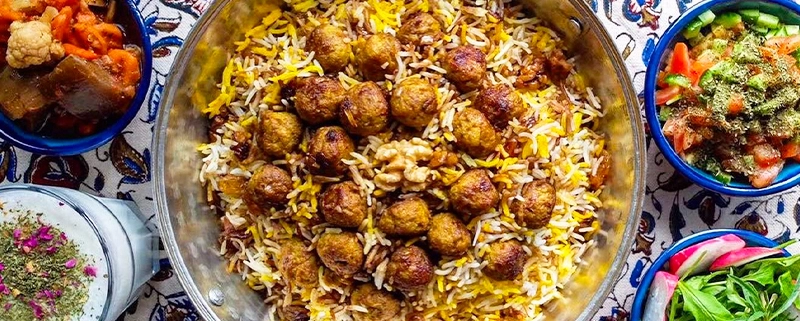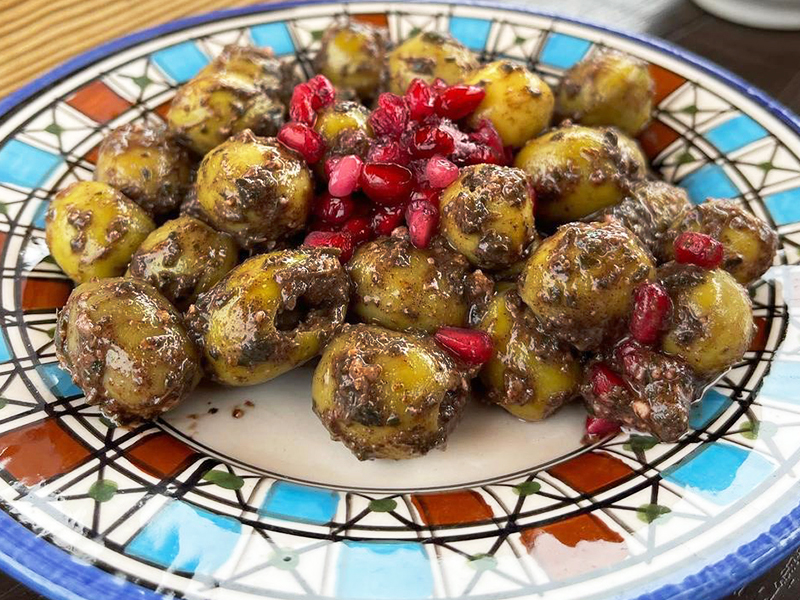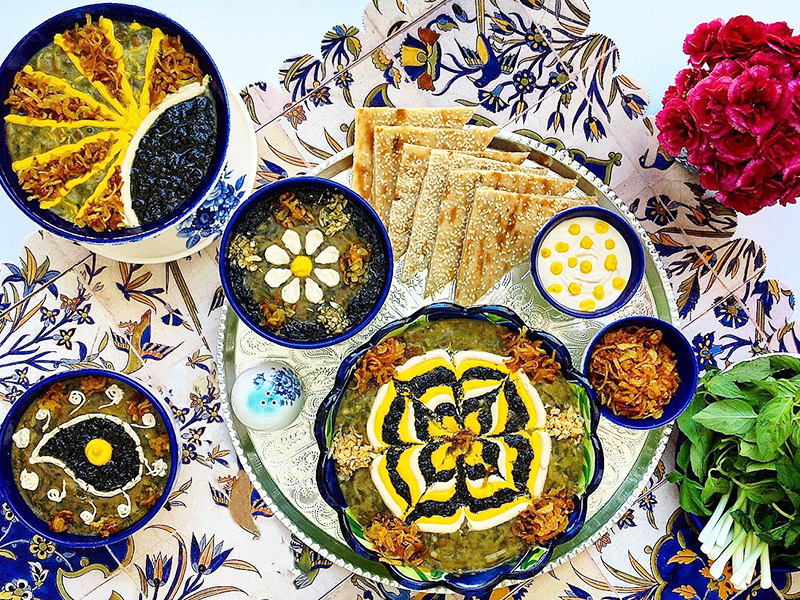Top 10 Persian Side Dishes
Do you know about the famous Iranian side dishes? Iranians have some of the best and savory side dishes favored by so many visitors from different parts of the world. These appetizers can fall into diverse categories, from soups and stew to yogurts and sweets. The Iranian people are very fond of cooking with tasty ingredients and seasoning them with excellent organic spices harvested from fresh farms. Eating these Persian side dishes with delicious Persian food touches all hearts.
Here, we will introduce you to the top Persian food side dishes that are easy to make and will make you lick your fingers.
Cold Persian Appetizers and Side Dishes
These no-cook and easy Persian side dishes will surely make your meals taste better. You can make them at home with no pressure and have them along with your main dish.
Read about the most unusual foods in Iran you should try!
Salad Shirazi
Shirazi salad is one of the number one Persian vegetable side dishes that originated from and is named after the city of Shiraz in southern Iran. This salad belongs to the Qajar era at the end of the nineteenth century when tomato was first introduced to the Iranians, so it is somewhat a more modern salad compared to other Persian side dishes. The salad contains chopped tomatoes, cucumbers, and onions in the shape of small cubes. The mixture is then flavored with verjuice, dried pennyroyal, parsley, and mint seasoned with black pepper and salt.
Torshi
Torshi is pickled vegetables stored in jars and served as a side dish. Torshi was first made in the Middle East and has been selected as a major appetizer in Iranian cuisine. According to regional customs and various events, Iran has hundreds of types of torshi made by the locals. The best torshi can be purchased in the north of Iran where the local ladies sell all kinds of colorful jars of torshi with five-star flavors you’ve never tasted before.
Torshi means “sour” in Persian, therefore the jarred vegetables and fruits usually bear a sour flavor. Some fruit Torshis may have a sweet taste or both sour and sweet, and the taste will depend on the meals that are served. It is best not to have torshi with yogurt.
Zeytun Parvardeh (Marinated Olives)
A delicious side dish originating from the north of Iran in Gilan Province. For marinating the fresh green olives pomegranate molasses, walnuts, garlic, mint, blue eryngo, and parsley are used to make this condiment. This Persian side dish goes well with almost all Persian dishes, especially with some of these top Iranian foods.
Zeytun Parvardeh is served with the main dish and is usually on the menu of most traditional restaurants in Iran. Zeytun Parvardeh is the specialty of the Northern locals of Iran. Try Zeytoon Parvardeh with the most popular northern dishes of Iran.
Yogurt
Yogurts in Iran are considered the must-have side dishes when having a meal. This appetizer has countless types and tastes when mixed with other ingredients. One of them is Mast-o Khiyar, which is a combination of yogurt, grated cucumbers, and mint. For a special flavor, you can use onions.
Another famous yogurt side dish is Mast Musir, which is yogurt and shallots mixed to create a savory yogurt. Most restaurants bring this yogurt along with a hot chicken soup before your main dish. Some like to use spinach with yogurt called “Borani,” which is then enriched with garlic.
A famous ingredient sold in northern Iran is “Dalar”. Dalar is a mixture of fresh local herbs combined with garlic and other spices. It is then blended into your fresh yogurt for an excellent Persian dish. Since yogurt is regarded as a distinguished side dish, Iranians use numerous ingredients to mix into it. Some more ideas are roasted eggplants, beetroot, damask roses, and saffron.
Shoor
The term shoor means salty in Farsi, which indicates that this Persian side dish has a salty taste to it. Shoor is usually made during autumn. This is because the ingredients used for shoor are grown during this season. It contains salted cauliflower and carrots stored in vinegar. Although shoor has many types, the most commonly made shoor includes cauliflower, carrots, celery, vinegar, salt, pepper, garlic, and green peppers.
Hot Persian Appetizers and Side Dishes
Hot appetizers will make your stomach warm and prepare you for the meal, and if you need a warm side dish before you start eating your main dish, these are some of the healthiest and yummy Persian food side dishes for you.
Aush
Aush is a thick soup usually served hot. It is part of Iranian cuisine and is served in almost all traditional Iranian restaurants. Aush is mostly cooked with a variety of ingredients. It may include flat wheat noodles, turmeric, legumes (chickpeas, kidney beans), herbs (dill, mint, coriander, minced cilantro), vegetables (broccoli, carrots, onion, celery, spinach), and in some Aush recipes, meat is optional such as ground lamb, beef or chicken.
Most Aush dishes can be used as both sides and main dishes, depending on how light it is for you to digest.
Aush-e Dough
This Aush is cooked with legumes such as chickpeas and lentils, greens, leeks, thyme, and garlic, and all kinds of mountainous and local vegetables. Finally, buttermilk is used to flavor it, which finalizes the dish. Dough means buttermilk, and this ingredient makes your Aush look creamy and light in color. Aush-e Dough is one of the tastiest Iranian appetizers and is commonly served in the cold seasons of the year.
Aush-e Jo
Aush-e Jo is one of the top traditional Iranian dishes and another extraordinary appetizer that is usually prepared on special occasions and holidays. The method of preparation of Aush-e Jo is almost similar to Aush Reshte, which includes beans and noodles. The only major difference is that it is made with barley, which is “jo” in Persian and is the main ingredient of this Aush.
Mirza-ghasemi
Mirza Ghasemi is also a very popular Iranian side dish originating from the Gilan province. Mirza Ghasemi dish was first made by Mohammad Qasim Khan, the governor of Rasht, during the reign of Naseruddin Shah, and this dish is named after him. Mirza-ghasemi is a renowned side dish in all the cities of Iran due to its delicious and special taste.
The grilled eggplant has a fantastic aroma, which has attracted countless visitors from all around the world. This dish is prepared with eggplants, tomatoes, eggs, and garlic cloves. Mirza-ghasemi is served with fresh Persian bread and vegetables.
Kashke Bademjan
Eggplant curd or Kashke Bademjan is a dip similar to Mirza-ghasemi and can be eaten with bread. This original and traditional Iranian appetizer can be easily prepared at home with readily available ingredients such as eggplants, curd, garlic, and onions and eaten with bread. If eggplants are one of your and your family’s favorite foods you should try this Persian side dish.
Kashke Bademjan is typically garnished with liquid saffron, sautéed onions, garlic, and often walnuts. The flavor of garlic is very important in this dish. Kashke Bademjan and Mirza-ghasemi are perfect side dishes for Persian lamb.
Dolme
Grape Leaf Dolme is among the best and savory dishes in the Middle East, which is also very famous in Iran. This delicious dish is prepared from the combination of rice with meat (soy for vegans), beans, and vegetables and is wrapped in grape leaves. According to your preferences, you can prepare the grape leaf rolls in the form of cylinders (pipe shape) or in the form of sticks, which is more common.
All the ingredients of Dolmeh Irani are made into a paste and wrapped inside a grape leaf. These leaves are then cooked in a pan and ready to be served as a flavorsome appetizer.
Kuku Sabzi
This appetizer is a delicious and popular Iranian side dish that is prepared with various recipes. Kuku Sabzi is a type of omelet made with eggs and vegetables. It is a side dish that can be served as a complete meal for dinner or lunch or as an appetizer or snack. Most commonly, Kuku Sabzi is served as an appetizer along with fish and rice.
To make this Iranian side dish, we have to make the kuku into a mold. A note about kuku sabzi is that this dish is prepared simply by combining vegetables and eggs, but if we want to make it in a more sophisticated and fancier way, we can also use ingredients such as barberry and walnuts.
Local Persian Bread
Iran boasts a ton of varieties in bread making. For Iranians, bread is a must-have on their table, and without it may feel like they lack something in the morning. Although these days industrial bread has replaced traditional bread, you still are able to buy traditional Persian bread from bakery shops on every corner of the street.
Some of the popular pieces of bread in Iran are lavash, sangak, barbari, nan mashhadi, taftun, shirmaal, ghagh, and different types of buns and baguettes. Based on every region in Iran, you will find thousands of traditional breads made by the locals living in those areas. The scent of freshly baked bread will enchant you once you stroll around in the cities of Iran.
Final Word
Visiting Iran is surely an exciting trip where can encounter some of the best archeological sites and discover rich Persian culture and history, as well as having the opportunity to taste traditional Persian cuisine. So, the next time you enter an Iranian restaurant, you can order some of these yummy and aromatic side dishes from the menu, and undoubtedly, once you have a bite of them, they will truly awaken your senses.
Are you planning to travel to Iran and looking for an Iran Travel Agency? Check out our Iran tours and Iran food tour.









Leave a Reply
Want to join the discussion?Feel free to contribute!